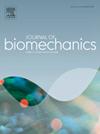本体感觉再加权是否有助于在类似滑倒的扰动过程中采取反应平衡策略?
IF 2.4
3区 医学
Q3 BIOPHYSICS
引用次数: 0
摘要
跌倒通常发生在行走过程中,尤其是在对意外干扰做出反应时。本体感觉在检测身体失稳方面发挥着重要作用,甚至在需要对扰动做出反应之前。本研究调查了本体感觉再权重策略对步行过程中反应性平衡的贡献。这项横断面概念验证研究包括 15 名健康成年人(18-40 岁)。踝部和背部肌肉振动器扰乱了站立时的本体感觉输入,从而可以计算本体感觉再加权指数。然后在 ActiveStep 跑步机上进行行走滑动扰动。线性回归模型评估了本体感觉再加权在预测滑步后稳定性(稳定幅度)方面的意义。参与者在闭眼的情况下,在泡沫表面上从以脚踝为中心的本体感觉策略转向以中心为中心的本体感觉策略(差异 = 15.70 % (SD=37.87), 95 %CI [0.41, 30.99], p = 0.045)。回归模型解释了触地前稳定幅度变异的 22.7%,泡沫上的本体感觉再加权显著促进了扰动后姿势控制(p本文章由计算机程序翻译,如有差异,请以英文原文为准。
Does proprioceptive reweighting contribute to reactive balance strategies during slip-like perturbations? a proof-of-concept in healthy adults
Falls commonly occur during walking, particularly when struggling to respond to unexpected perturbations. Proprioception plays a significant role in detecting body destabilization even before reactions to perturbations are required. This study investigates the contribution of proprioceptive reweighting strategies to reactive balance during walking. This cross-sectional, proof-of-concept study included fifteen healthy adults (18–40 years). Ankle and back muscle vibrators disrupted proprioceptive input in stance, allowing calculation of the proprioceptive reweighting index. Walk-slip perturbations were then administered on an ActiveStep treadmill. A linear regression model assessed the significance of proprioceptive reweighting in predicting post-slip stability (margin of stability). Participants shifted from an ankle-steered to a central-steered proprioceptive strategy on a foam surface with closed eyes (Difference = 15.70 % (SD=37.87), 95 %CI [0.41, 30.99], p = 0.045). The regression model explained 22.7 % of the variance in pre-touchdown margin of stability, with proprioceptive reweighting on foam significantly contributing to post-perturbation postural control (p < 0.001). Proprioceptive reweighting provides a moderate explanation for the mechanisms of reactive balance, highlighting that the key to effective balance recovery strategies may lie in the person’s ability to both detect and respond to imbalances. Further research should explore if these proprioceptive strategies are a matter of directional control and if responses differ in older adults.
求助全文
通过发布文献求助,成功后即可免费获取论文全文。
去求助
来源期刊

Journal of biomechanics
生物-工程:生物医学
CiteScore
5.10
自引率
4.20%
发文量
345
审稿时长
1 months
期刊介绍:
The Journal of Biomechanics publishes reports of original and substantial findings using the principles of mechanics to explore biological problems. Analytical, as well as experimental papers may be submitted, and the journal accepts original articles, surveys and perspective articles (usually by Editorial invitation only), book reviews and letters to the Editor. The criteria for acceptance of manuscripts include excellence, novelty, significance, clarity, conciseness and interest to the readership.
Papers published in the journal may cover a wide range of topics in biomechanics, including, but not limited to:
-Fundamental Topics - Biomechanics of the musculoskeletal, cardiovascular, and respiratory systems, mechanics of hard and soft tissues, biofluid mechanics, mechanics of prostheses and implant-tissue interfaces, mechanics of cells.
-Cardiovascular and Respiratory Biomechanics - Mechanics of blood-flow, air-flow, mechanics of the soft tissues, flow-tissue or flow-prosthesis interactions.
-Cell Biomechanics - Biomechanic analyses of cells, membranes and sub-cellular structures; the relationship of the mechanical environment to cell and tissue response.
-Dental Biomechanics - Design and analysis of dental tissues and prostheses, mechanics of chewing.
-Functional Tissue Engineering - The role of biomechanical factors in engineered tissue replacements and regenerative medicine.
-Injury Biomechanics - Mechanics of impact and trauma, dynamics of man-machine interaction.
-Molecular Biomechanics - Mechanical analyses of biomolecules.
-Orthopedic Biomechanics - Mechanics of fracture and fracture fixation, mechanics of implants and implant fixation, mechanics of bones and joints, wear of natural and artificial joints.
-Rehabilitation Biomechanics - Analyses of gait, mechanics of prosthetics and orthotics.
-Sports Biomechanics - Mechanical analyses of sports performance.
 求助内容:
求助内容: 应助结果提醒方式:
应助结果提醒方式:


